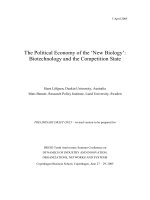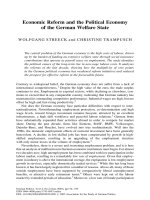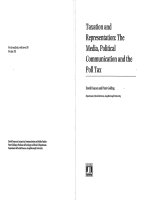Green growth ideology political economy and the alternatives
Bạn đang xem bản rút gọn của tài liệu. Xem và tải ngay bản đầy đủ của tài liệu tại đây (4.56 MB, 336 trang )
www.ebook3000.com
‘The Asia-Pacific Network for Global Change Research
(APN) is delighted to be a part of this publication, which is
expected to produce long-term gains by enhancing scientific
and policy capacity on green growth in the context
of sustainable development.’
Linda Anne Stevenson, Division Head,
Communication and Scientific Affairs, APN
www.ebook3000.com
About the editors
Gareth Dale is a political economist at Brunel University. He gained
his doctorate in government at Manchester University. His expertise is
in political and economic thought, with a focus on growth/degrowth.
Manu V. Mathai is assistant professor in the School of Development
at Azim Premji University. He received his PhD in energy and environmental policy from the Center for Energy and Environmental Policy
at the University of Delaware. He researches and teaches about the
intersection of energy, environment and human development.
Jose A. Puppim de Oliveira teaches at the Getulio Vargas Foundation
(FGV-EAESP and FGV-EBAPE) as well as the Federal University of
Rio de Janeiro (COPPEAD-UFRJ) and Fudan University, Shanghai.
He is also a visiting research fellow at United Nations University
(UNU-IIGH), Kuala Lumpur. He was assistant director and senior
research fellow at the United Nations University (UNU-IAS) from
August 2009 to 2015. His academic interests are in the political
economy of sustainable development, particularly in patterns of environmental governance and in the implementation of global policies at
the local level.
www.ebook3000.com
GREEN
GROWTH
IDEOLOGY, POLITICAL ECONOMY
AND THE ALTERNATIVES
E d i t e d by
G AR E T H DA LE , M A NU V. MATHAI
a n d J O S E A . P U P P I M D E O LIVEIRA
Zed Books
L ONDON
www.ebook3000.com
Green Growth: Ideology, political economy and the alternatives
was first published in 2016 by Zed Books Ltd,
The Foundry, 17 Oval Way, London SE11 5RR, UK.
www.zedbooks.co.uk
Editorial copyright © Gareth Dale, Manu V. Mathai
and Jose A. Puppim de Oliveira 2016
Copyright in this collection © Zed Books 2016
The rights of Gareth Dale, Manu V. Mathai and Jose A. Puppim de Oliveira
to be identified as the editors of this work have been asserted by them in
accordance with the Copyright, Designs and Patents Act, 1988.
Typeset in Sabon by seagulls.net
Index: Clare Birkett
Cover design: www.clareturner.co.uk
All rights reserved. No part of this publication may be reproduced,
stored in a retrieval system or transmitted in any form or by any
means, electronic, mechanical, photocopying or otherwise,
without the prior permission of Zed Books Ltd.
A catalogue record for this book is available from the British Library.
ISBN 978-1-78360-488-3 hb
ISBN 978-1-78360-487-6 pb
ISBN 978-1-78360-489-0 pdf
ISBN 978-1-78360-490-6 epub
ISBN 978-1-78360-491-3 mobi
www.ebook3000.com
CONTENTS
Acknowledgementsvii
Contributorsix
Introduction1
Gareth Dale, Manu V. Mathai and Jose A. Puppim de Oliveira
Part I: Contradictions of green growth
1 Can green growth really work? A reality check that
elaborates on the true (socio-)economics of climate change
22
Ulrich Hoffmann
2 What is the ‘green’ in ‘green growth’?
42
Larry Lohmann
3 The how and for whom of green governmentality
72
Adrian Parr
4 Degrowth and the roots of neoclassical economics
90
James Meadway
Part II: Case studies
5 Giving green teeth to the Tiger? A critique of ‘green growth’ 114
in South Korea
Bettina Bluemling and Sun-Jin Yun
www.ebook3000.com
6 Lessons from the EU: why capitalism cannot be
rescued from its own contradictions
131
Birgit Mahnkopf
7 The green growth trap in Brazil
150
Ricardo Abramovay
8 Green jobs to promote sustainable development:
creating a value chain of solid waste recycling in Brazil
Anne Posthuma and Paulo Sergio Muçouçah
166
9 Trends of social metabolism and environmental conflict:
a comparison between India and Latin America
187
Joan Martinez-Alier, Federico Demaria, Leah Temper
and Mariana Walter
Part III: Emerging alternatives?
10Beyond ‘development’ and ‘growth’: the search for
alternatives in India towards a sustainable and equitable
world
212
Ashish Kothari
11Reconsidering growth in the greenhouse: the Sustainable
Energy Utility (SEU) as a practical strategy for the
twenty-first century
Job Taminiau and John Byrne
233
12Alternatives to green growth? Possibilities and
contradictions of self-managed food production
253
Steffen Böhm, Maria Ceci Araujo Misoczky,
David Watson and Sanjay Lanka
Notes271
Index315
www.ebook3000.com
ACKNOWLEDGEMENTS
We would like to express our gratitude to many organizations and
individuals that made this book possible. We thank the Asia Pacific
Network for Global Change Research (APN) for the support we
received from the Scientific Capacity Building/Enhancement for
Sustainable Development in Developing Countries (‘CAPaBLE’)
programme through the project ‘Training Workshop and Edited
Volume on “Green Growth: Political Ideology, Political Economy
and Policy Alternatives”’ (Reference CBA2014-09NSY-Mathai),
particularly Akio Takemoto and Hiroshi Tsujihara, former and
current director of APN, as well as Linda Stevenson and Christmas
de Guzman.
We are grateful for the support we received from the United Nations
University Institute for the Advanced Studies of Sustainability for
organizing the Green Growth Symposium in July 2014, especially
to Govindan Parayil and Kazuhiko Takemoto, former and current
director of UNU-IAS, as well as Takei Chiharu, Nakano Yuki, Fueta
Natsuko, Sayo Yoshitake, Yukie Sawada, Shio Terui and the students
Xue Ye (Susie), Richard Rastall and Alexis Nakandakari.
We are grateful to the British Academy, which funded Gareth
Dale’s attendance at the Tokyo symposium (Mid-Career Fellowship,
2013–14), to the Daiwa Anglo-Japanese Foundation for a generous
grant that enabled UK-based young researchers to attend, and to the
20 young researchers from around the world who helped make the
symposium a success.
Finally, we are appreciative of Kim Walker and her team at Zed
Books who have smoothly steered the volume towards completion.
www.ebook3000.com
www.ebook3000.com
CONTRIBUTORS
Ricardo Abramovay is professor of economics at the University of São
Paulo and author of Beyond the Green Economy (Routledge, 2016).
Bettina Bluemling lectures at the University of Glasgow, and is
research fellow at the Leibniz Institute of Agricultural Development
in Transition Economies, Germany.
Steffen Böhm teaches at the Environment and Sustainability Institute
at the University of Exeter. His research focuses on political economies and ecologies of the food–energy–water–carbon–environment
nexus. His most recent book is Ecocultures: Blueprints for Sustainable Communities (Routledge, 2014).
John Byrne is the director and distinguished professor of energy and
climate policy at the Center for Energy and Environmental Policy (CEEP),
co-founder of the Foundation for Renewable Energy and Environment,
and the architect of the Sustainable Energy Utility (SEU) model.
Federico Demaria is a researcher at the Institute of Environmental
Science and Technology, Autonomous University of Barcelona (IEST,
UAB) with an affiliation at the CSSP JNU (India). His research deals
with waste-related environmental conflicts and ‘accumulation by
contamination’. He co-edited Degrowth: A Vocabulary for a New Era
(Routledge, 2014).
Ulrich Hoffmann is chief economist, sustainability issues at the
Research Institute on Organic Agriculture (FIBL), and former editorin-chief of the UNCTAD Trade and Environment Review, UNCTAD
Secretariat.
www.ebook3000.com
x | Contributors
Ashish Kothari is a founder of the Indian environmental group
Kalpavriksh. Active in movements relating to development, conservation, and natural resource rights, he is the author or editor of over 30
books, including (with Aseem Shrivastava) Churning the Earth: The
Making of Global India.
Sanjay V. Lanka works with coffee cooperatives of indigenous farmers
with a focus on fairtrade and biodiversity with regards to the delivery
of sustainable livelihoods, using accounts from the margins. He’s
finalizing his PhD at the University of Essex.
Larry Lohmann works for Corner House.
Birgit Mahnkopf is professor of European politics at the Berlin School
of Economics and Law. She received her PhD in sociology and her
post-doctoral habilitation at the Freie Universität Berlin. She has
published 12 books and over 130 articles and book chapters.
Joan Martinez-Alier is professor emeritus at UAB (Spain) and
FLACSO, Quito, Ecuador. He is the author of Ecological Economics:
Energy, Environment and Society and The Environmentalism of the
Poor: A Study of Ecological Conflicts and Valuation.
James Meadway is senior economist at the New Economics Foundation.
Maria Ceci Araujo Misoczky is a professor and researcher of Organization Studies at the Federal University of Rio Grande do Sul, Brazil.
Her research interests include the organization of social struggles,
focusing on socio-environmental conflicts and anti-capitalist movements in Latin America.
Paulo Sérgio Muçouçah is the coordinator of decent work and
green jobs programmes at the International Labour Organization
(ILO) in Brazil.
Adrian Parr teaches sociology at the University of Cincinnati. She is
UNESCO co-chair of water.
Anne Caroline Posthuma is senior specialist in employment policies at
the Office of the ILO in Brazil.
Contributors | xi
Job Taminiau is a post-doctoral fellow at the Center for Energy and
Environmental Policy (USA) and a research associate at the Foundation for Renewable Energy and Environment interested in the
localization of global climate change policy.
Leah Temper is a post-doctoral researcher in environmental history
and ecological economics at UAB and a freelance environmental journalist and video artist. She researches ecological conflicts and social
metabolism and she has undertaken fieldwork on conflicts related to
land use, mining and energy in Israel, Kenya, Ecuador and India. She
coordinates the EJAtlas (www.ejatlas.org).
Mariana Walter is a post-doctoral researcher at IEST (UAB) and
at the International Institute of Social Studies, Erasmus University
Rotterdam. She researches the political ecology of mining conflicts
in Latin America and is developing a framework for sustainable and
equitable natural resource use.
Dave Watson is finalizing his PhD at the University of Essex. His
research focuses on how participation in community food initiatives
impacts on well-being.
Sun-Jin Yun is a professor at Seoul National University. She completed
her PhD in environmental and energy policy at CEEP.
INTRODUCTION
Gareth Dale, Manu V. Mathai and Jose A. Puppim de Oliveira
‘Green growth’, together with the related ‘green economy’, represents
the latest phase in the reconstruction of political discourse in the face
of ecological challenges and environmental movements. It encompasses approaches ranging from geo-engineering mega-projects
to routine ‘efficiency strategies’. By such means, it promises to stem
the environmental crisis and mitigate its consequences while simultaneously addressing social challenges of destitution and disempowerment. It is a project with a utopian charge, depicting a path to the
future that, thanks to scientific insight, engineering sophistication
and managerial smartness, is capable of redressing the accumulated
harms of the ‘old’ industrial paradigm. At the same time, at least
in its mainstream variants, it claims to embody a sober realism: the
route toward a sustainable future need not stray outside the institutional and normative territory of the current political economic
prevalent ideas.
At face value, green growth appears impervious to critique. Yet
objections have been levelled against it from several different directions. This volume gives a platform to a variety of its critics. Common
to all is a concern that green growth agendas tend to buy into the
illusion that techno-economic fixes and improvements in the management of markets will enable the path of endless growth to continue,
in harmony with the environment. Some, notably Ulrich Hoffmann
in Chapter 1, focus upon the question of climate change. Is global
economic growth, however ‘green’, compatible with capping a rise
2 | Introduction
in the planetary average temperature at two degrees Celsius above
the pre-industrial level? If the required reductions in carbon emissions cannot be achieved through a declining carbon intensity of
production, then the green growth project, far from being ‘realistic’,
would be a utopia, a mirage that serves only to flatter the ability
of existing power structures to tackle ecological challenges. Others
focus attention upon those power structures themselves. For Job
Taminiau and John Byrne (Chapter 11), the green growth project
exemplifies the incorporation of environmental narratives into ‘the
modernization project’, with critical attention devoted solely to the
‘“end-of-pipe” consequences of current social relations to the environment’, i.e. the pollutive excretions of modern industrialism, to
the exclusion of the social organism from which they flow, with its
corporate energy systems, class differences that generate ‘capitalist
expansion and community fragmentation’, and strikingly inegalitarian patterns of wealth distribution. For James Meadway (Chapter
4), the problematic centres upon the accumulation of capital, which
necessarily demotes the relationship between humanity and nature to
a subsidiary concern, while Adrian Parr (Chapter 3) puts ‘neoliberal
governmentality’ in the frame, a mode of power that elevates capital
accumulation to ‘a principle of governance’, with green growth
understood not as merely ‘another instance of the misuse of state or
corporate power’ but as a strategic initiative to elevate principles of
economic competition to the guiding mechanism of humanity’s interaction with the natural environment. This, the meaning of the ‘green’
in green growth, is the subject of Larry Lohmann’s chapter (Chapter
2). Green growth stands for a new mode of human engagement with
the environment, with nature reconceived as a type of capital, a
collection of tradable ecosystem services that are ‘mobilized to defend
productivity gains, minimize costs of capital expansion, and stave
off crises of reproduction’. Just as in earlier eras the commodity of
labour-power was ‘unbundled from the human activity of commoners
(or slaves) and made ownable and transferable’, Lohmann argues, so,
in the dawning era of the green economy, ‘carbon-cycling capacity
and other ecosystem services are to be unbundled from the activities
of the earth and made circulatable and accumulable’.
Introduction | 3
Genesis of green growth
Green growth has not come out of the blue but has supervened upon
earlier environmental–economic agendas. In the 1970s, environmentalism went mainstream, as soaring oil prices fuelled concern with
natural ‘limits to growth’, accompanied by the advent of ‘ecological
economics’ and a series of moral critiques of industrial civilization
such as Blueprint for Survival. In 1972 the United Nations (UN)
proclaimed its Stockholm Declaration on the Environment. In the
same year, the Organisation for Economic Co-operation and Development (OECD) announced the ‘Polluter Pays Principle’, which
proposed that the costs of cleaning up contamination be paid by those
who caused it, and is arguably one of the seeds of the green economy
idea.1 Two years later the World Council of Churches conference in
Bucharest coined the phrase ‘ecologically sustainable society’. There
followed, in quick succession, a series of reports by state-sponsored think tanks (notably the Hammarskjöld Foundation and the
Brandt Commission) that warned against the conflation of growth
and development. ‘Sustainable development’ became the buzzword
of the time; the idea that could make compatible economic development with social goals and environmental protection. It connoted
grassroots engagement, equality and social justice, local empowerment and low-impact development. Slowly but surely, however, its
radical threads were appropriated by sustainable development’s official sponsors: the UN, plus an array of NGOs and think tanks. By
1987 the official hour of sustainable development had arrived: the
UN-backed Brundtland Commission defined it as ‘development that
meets the needs of the present without compromising the ability of
future generations to meet their own needs’.2 Five years later, at the
Rio Earth Summit, it assumed a starring role as gospel and mantra of
the mainstream environmental movement.
Despite (or because of) the social democratic aspirations embodied
in ‘sustainable development’ it was always under suspicion of
applying a green gloss to capitalist expansion in the global South.
Its critics, such as Sharachchandra Lélé, dismissed it as ‘a fashionable phrase that everyone pays homage to but nobody can define’.3
Some wondered whether the ‘new paradigm’ it promised was ‘simply
4 | Introduction
a greenwash over business-as-usual’.4 Others perceived in it a hegemonic ‘cover-up operation’ designed to reassure a public anxious over
the consequences of economic growth that these could be ameliorated without the need for any ‘radical challenge’ to the prevailing
economic system.5 Little by little, ecological meanings were usurped,
such that by the 2000s sustainable development had become all but
synonymous with ‘sustained economic growth’.6
As sustainable development – the discourse and project – lost its
way, it gradually, inexorably, found itself folded into a new framework: green economy and ‘green growth’. At first sight these could
appear simply as a reprise of sustainable development. However, their
emergence was significant in that they steered the existing debate in
a particular direction. In the green economy discourse three aspects
stand out in comparison to its ‘sustainable development’ predecessor.
First, its variants belong for the most part to the tradition known
as ‘green (neo)liberalism’. They insist much more assertively than
the ‘sustainable development’ school had done that environmental
sustainability is not only compatible with but also depends upon the
market system. Hope for the world lies with an eco-industrial revolution driven by technological innovation and steered by market signals.
‘Going green’ is an economic opportunity; its heroes are ‘sustainable
entrepreneurs’, banks and corporations. Second, green growth stands
for new methods of intervention in the environment, with nature
reframed as ‘a specific type of capital, which needs to be measured,
conserved, produced and even accumulated’.7 Green growth strategies
were fashioned as tools to enclose commons and to isolate elements of
enmeshed relationships, bringing into being purportedly autonomous
categories such as ‘genes’, ‘carbon sinks’ or ‘pollination’ and, more
generally, ‘ecosystem services’, which can be externalized, commodified and monetized for exchange. For instance, the response to climate
change-induced meteorological unpredictability is to market genetically engineered crops for ‘drought resistance’ or ‘heat tolerance’,
rather than to develop strategies of reviving and strengthening the
astounding diversity of crops and planting methods, and water and
soil nutrient management practices, and still less to place constraints
upon free trade or speculation in agricultural commodities markets
or the spread of highly processed, monocultured food habits. Third,
Introduction | 5
whereas sustainable development tended to foreground questions of
social justice, conservation and the active state, these are noticeable
by their absence within the green economy framework. As Bluemling
and Yun put it (Chapter 5), whereas sustainable development tended
to favour ‘civil society engagement’, green growth, in their case study
of South Korea, has been introduced and managed as a top-down
presidential project, to be executed by technocrats. If, in its origins,
sustainable development tended to go hand in hand with commitments to democratization, wealth redistribution and the political
oversight of markets, these found themselves increasingly marginalized in the decades of neoliberal ascendancy that followed the fall of
the Berlin Wall.
It was when the neoliberal paradigm appeared to wobble, in the
early 2000s and then egregiously in the wake of the global economic
crisis of 2008, that the green growth idea arose. In the North, economic
growth collapsed, and remained sluggish even after the initial crisis had
subsided. Some blue-chip behemoths collapsed while others staggered
under mountainous losses – a gargantuan debt burden that was quickly
and slickly transferred to taxpayers. Social polarization accelerated,
and established parliamentary parties faced sullen or angry electorates.
In such circumstances, the mainstream policy regime faced a legitimacy
crisis, to which, broadly speaking, three responses were seen as possible.
One was to urge it to march on as if nothing had happened – what some
refer to as ‘zombie neoliberalism’.8 Another was to seek self-reinvention – a sort of reflexive modernity. It is in this connection, in keeping
with Ecological Modernization Theory (EMT), that a good deal of the
green growth (and green economy) agenda should be understood. A
stand-out example is the case of South Korea under the administration of Lee Myung-bak, discussed by Bluemling and Yun (Chapter 5).
Under President Lee, green growth was pushed hard, and not merely
as a set of policies but as a means to create, in Lee’s words, ‘a new
civilization’. On the global stage, the green economy and green growth
were introduced as a central thematic of ‘Rio+20’, the UN Conference
on Sustainable Development in Rio de Janeiro.9 A third response was
to propose the demise and replacement of the neoliberal order. Here,
too, environmental issues played a prominent part, as witnessed in the
reports by Britain’s ‘Green New Deal Group’, with its demand for a
6 | Introduction
Keynesian programme of crisis resolution centred on environmentally
oriented fiscal stimuli. Marginally to the mainstream debates, a series
of grassroots initiatives also emerged as possible alternatives to green
growth, as we will discuss later.
Green growth, in short, can be seen as the most recent ‘materialsemiotic’ reformulation of nature–society relations offered up by a
contemporary capitalism, one that found a particularly receptive audience in the wake of the crisis of 2008. It has persuasive power because
it ‘constitutes a plea for sustainable development without tears’.10
Relatedly, most of its variants purport to address a range of systemic
contradictions but in an explicitly apolitical (or ‘post-political’) way. It
is an approach that is Pollyanna-like in its technological optimism, in
its belief that ecological and social crises can be overcome by the same
general approaches that underpinned the policy framework in the
preceding ‘brown’ era: innovations in technique (encompassing science
and engineering, finance and law) and renewed rounds of enclosures
and commodification. In this, the foregrounded aims of environmental
improvement, economic growth and rising living standards all appear
to be non-contentious and ‘apolitical’, even as the means by which
they are to be achieved are political to the core: the cementing of the
neoliberal policy agenda within the field of environmental political
economy.11 To a certain extent, the green growth agenda is reminiscent
of the Washington Consensus: a set of loosely connected economic
principles and policy initiatives that gained widespread consensus
among political and economic elites, found powerful backing in international organizations and particular nation states, and did not suffer
much in the way of resistance in the early period of its dissemination.
Ultimately, its consequences came to be felt, in the form of widening
inequality and social dislocation, and movements of resistance arose.
Is green growth headed in a similar direction?
Contradictions of green growth
The social and ideological prominence of economic growth – or
the ‘growth paradigm’: the doctrine that economic growth is good,
imperative, essentially limitless, and a matter of pressing concern for
society as a whole – flows from fundamental societal transformations
Introduction | 7
associated with the advent of modernity (the linearization of time,
the notion of progress, the dissolution of just wage norms, and the
quantification of processes of wealth production and distribution),
and the rise of industrial capitalism together with its corollary, the
commodification of nature and society. In an early effort to characterize and justify the new paradigm, Adam Smith speculated that
it is ‘in the progressive state’, when society ‘is advancing to the
further acquisition, rather than when it has acquired its full complement of riches, that the condition of the labouring poor, of the great
body of the people, seems to be the happiest’.12 It is in a state of
continual economic growth that emancipatory potential is achieved.
And, indeed, the subsequent two centuries of industrial capitalism
did significantly advance the ‘acquisition of riches’, as well as raising
life expectancy, eroding feudal and patrimonial forms of personal
economic dependence, and catalysing advances in individual liberty
and democracy that, although crassly uneven in quality and application, were global in scale and momentous in scope.
This narrative of the ‘progressive state’ of capitalist modernity is
now struggling to retain its coherence in three respects. One is internal
to the growth paradigm itself. The system’s own yardstick of success,
global per capita GDP growth, has for several decades followed a
downward trajectory. Although global capitalism is systemically
‘compelled towards growth’, as Meadway puts it (Chapter 4), it
appears to be ‘decreasingly able to deliver it’. The second is a scepticism vis-à-vis the ‘Smithian promise’ that growth will emancipate the
poor. Against a backdrop of vulgar levels of income inequality, the
supposed connection between economic growth and social well-being
has been increasingly called into question.13 Insofar as a perceptible
relationship between GDP growth and well-being exists, it tends to
decline after a certain point – as a rule of thumb, when per capita
GDP exceeds around $15,000 – and today’s average global per capita
GDP, at $6,000 per head, is now greater than that for the Western
world in 1950. It is perhaps fortunate, Richard Wilkinson and Kate
Pickett have argued, that ‘just when the human species discovers that
the environment cannot absorb further increases in emissions, we also
learn that further economic growth in the developed world no longer
improves health, happiness or wellbeing’.14
www.ebook3000.com
8 | Introduction
The third is a growth scepticism fuelled by concerns over the diminishing ecological space available to supply non-renewable resources
and to absorb the effluents of ongoing growth. Ecological thresholds
are being breached, and ‘tipping points’ appear to be upon us. To this,
the dominant response has long been one or other variant of ‘green
growth’: the idea that investment in the production of knowledge,
the resulting innovations in technique, environmental awareness that
purportedly comes with rising incomes, and a structural shift towards
fewer resource and energy-intensive service sector industries will ‘save
the planet’. In its formalized version, this idea came to be known as
the Environmental Kuznets Curve (EKC). The EKC holds that, after
a certain point, economic growth correlates strongly with greater
efficiency in resource use. At low levels of economic development, a
nation’s output is too low to generate much pollution. As GDP grows,
environmental damage initially grows too, but when a high income
level is reached, an inflexion point after which new factors come into
play: economic growth becomes increasingly ‘dematerialized’, and
people become ‘rich enough to care about pollution and take steps
to reduce it’.15 From then on, environmental degradation tends to fall
even as incomes rise further.16 The ecological economist Herman Daly
calls this the ‘hair of the dog that bit you’ approach.17
The hypothesis that there exists a simple, inverse relationship
between per capita income and environmental stress has been challenged on a number of counts. Firstly, the idea that concern for the
environment is a privilege of rich people is baseless. It ignores the
‘environmentalism of the poor’ about which Martinez-Alier et al.
write in Chapter 9 and Ashish Kothari in Chapter 10. And, as Anne
Posthuma and Paulo Sergio Muçouçah remind us in Chapter 8, it
is invariably the poor among us who clean up and recycle society’s
waste. Secondly, if the EKC hypothesis has held in particular conditions, then only with respect to pollutants that have short-term costs,
such as particulates, and not with respect to accumulating wastes or
to pollutants involving long-term costs, such as greenhouse gas emissions (GHGs). Decreases in some pollutants, its critics point out, are
often associated with increases in other pollutants within the same
country or transfers of pollution to other countries. The EKC hypo
thesis ignores the fact that reduced pollution in developed countries
Introduction | 9
is often part of the same processes – above all, the outsourcing of
manufacturing – that determine the expansion of resource-intensive
production elsewhere.18 Rather than income growth leading to an
amelioration of pollution, what seems to be happening is a dynamic,
multifactorial and context-dependent interplay between ‘scale effect’
and ‘time effect’. For example, where developing countries take
measures to reduce pollution, the higher economic growth rate and
resulting increase in pollution – the scale effect – overwhelms their
efforts, whereas in slower-growing developed countries the scale effect
is subdued.19 While at face value this might appear to validate the
EKC hypothesis, it is undermined by evidence of the environmental
performance of economic growth at the macro scale. If macro indicators of environmental stress, such as ‘ecological footprint per unit
of well-being’, are assessed, the findings tend to result in a U-shaped
curve when plotted against per capita income.20 Such results are in
keeping with critiques of ecological modernization theory,21 which
find that, regulatory, energy and material intensity improvements
notwithstanding, ‘modernization leads to supermaterialization rather
than dematerialization’ at the macro scale.22 For instance, Wiedmann
et al. record the divergence between Domestic Material Consumption (often seen to be in decline in developed countries) and these
same economies’ overall Material Footprint, which in many cases is
rising, due to the externalization of material consumption through
international trade and the relocation of energy and material intensive mining and manufacturing industries.23 Martinez-Alier and his
co-authors (Chapter 9) find such patterns in international trade
to be a trend pointing to the ‘structural persistence of ecologically
unequal exchange’. They argue that oft-underappreciated ‘physical
and socio-environmental trade-offs at play’ call into question the
purported economic growth and development benefits accruing to
export-intensive economies of the South.
A major hope of green growth advocates, on which much of their
case rests, is that efficiency gains will negate overall increments in attendant energy and material throughput, including a dramatic reduction of
GHG emissions. But this, as noted by Bluemling and Yun in Chapter 5,
is much too sanguine, not least because it neglects to consider the ‘Jevons
paradox’. In his book The Coal Question: An inquiry concerning the
10 | Introduction
progress of the nation, and the probable exhaustion of our coal-mines
(1865), the British neoclassical economist William Jevons expressed an
anxiety that the depletion of its coal supplies will lead to Britain’s industrial decline and consequent loss of imperial dominance. One seemingly
obvious solution would be to effect improvements in the efficiency of
steam engines and furnaces; surely that would lead to a reduction in
the rate of depletion. In fact, the opposite occurred: it was ‘the very
economy’ of the use of coal that led to its more rapid consumption. ‘If
the quantity of coal used in a blast-furnace be diminished in comparison with the yield,’ he reasoned,
the profits of the trade will increase, new capital will be attracted,
the price of pig-iron will fall, but the demand for it increase;
and eventually the greater number of furnaces will more than
make up for the diminished consumption of each. And if such is
not always the result within a single branch, it must be remembered that the progress of any branch of manufacture excites a
new activity in most other branches, and leads indirectly, if not
directly, to increased inroads upon our seams of coal.24
The improved technological efficiency in the utilization of a natural
resource, within a capitalist framework, tends not to decrease but
to increase its rate of consumption, because its relative cost is lessened, freeing up capital for alternative uses. This is a key reason why
the ability of efficiency strategies to successfully address the crisis in
society–nature relations is likely to remain limited.
On one vital issue, that of reductions in GHGs, the EKC hypothesis
may yet turn out to be valid – but in a perverse and unconstructive way.
That is to say, it is perfectly conceivable that in the coming decades
continued global economic growth will coincide with reductions in
total emissions, yielding a classic Environmental Kuznets Curve: low
emissions and low output in the nineteenth century; high emissions
and rising GDP in the twentieth; steady or diminishing emissions
alongside rising GDP in the twenty-first. At face value it is a soothing
prospect, and it is at the heart of the green growth prospectus.
Economic growth, it appears to promise, may continue unabated even
as emissions decline, thanks to a decoupling of growth from resource
Introduction | 11
throughput. However, for genuine progress to be achieved on this
front, the decoupling of GHG emissions from GDP growth would
have to occur rapidly, globally and permanently. Crucially, decoupling
would have to be absolute (with an absolute decline in emissions)
rather than relative (a decline in the ratio of emissions to GDP).
According to Hoffmann (Chapter 1), this is not a feasible programme.
The limitation of global warming to the comparatively safe figure
of 2˚C would require a reduction in the global carbon intensity of
production to 36gCO2/$ – a 21-fold improvement on the current
global average.25 If this were attempted while countries of the global
South seek a level of per capita GDP comparable with the EU average,
a much greater reduction would be required – of nearly 130 times
over the next 35 years. To put this in perspective, consider the actual
historical instances in which emissions reductions have occurred.
Apart from a brief window in post-unification Germany, Russia is the
only sizeable economy that has seen a substantial emissions reduction
in recent times. Its carbon emissions fell by almost 3 per cent annually
in 1990–2005 – and that was thanks to industrial collapse. The world
would have to repeat that experience, and without Russia’s fall-back
on hydrocarbons (and the credit lines based on them), for decades on
end and at roughly three times the rate to even achieve medium-term
limitation of global warming to the far-from-safe figure of 3˚C. To
believe that emissions reductions on the scale required is compatible
with a growth-oriented world economy is utopian folly.
Green growth in practice
According to the United Nations, green growth first gained shape
as a strategic project in 2005; specifically, at the Fifth Ministerial
Conference on Environment and Development, at which ‘52 Governments and other stakeholders from Asia and the Pacific agreed to
move beyond the sustainable development rhetoric and pursue a path
of “green growth”’.26 The conference venue was Seoul, and this was
no coincidence. South Korea has been instrumental in promoting
the concept. In 2008, at the onset of the world economic crisis, the
Lee administration adopted green growth as its ‘new development
vision’, and a year later the National Strategy for Green Growth
12 | Introduction
and Five-Year Plan for Green Growth were announced. However, as
Bluemling and Yun document in Chapter 5, when the layers of rhetoric were peeled from Lee’s Green Growth Plan, its core was revealed
to be nuclear energy expansion, land reclamation, canal cutting and
dredging, and the construction of a multitude of dams and weirs – all
of which would place further strain upon the country’s beleaguered
natural environment. It was little surprise when Lee’s green growth
initiative faced a barrage of criticism, or that the following government, under President Geun-hye Park, considered ‘ditching’ green
growth altogether.27
A second aspirant to green growth leadership, the European Union,
is discussed by Birgit Mahnkopf in Chapter 6. Mahnkopf details
a number of the EU’s headline initiatives, such as the ‘20–20–20’
programme which sets binding targets for the year 2020: a reduction in
GHG emissions of 20 per cent below 1990 levels, a 20 per cent reduction in primary energy use compared with projected levels (via energy
efficiency measures), and then a raising to 20 per cent of the proportion
of energy supplied from renewable resources (including biofuels). As
in the Korean case, however, the initial fanfare has been followed by
disappointing results. Green growth, she writes, has been welcomed
only insofar as it represents ‘a win–win situation’ for the corporate
sector, with an emphasis upon efficiency strategies and new technological innovations, so long as profits are not harmed. Thanks in part
to corporate lobbying, the picture ‘is of a counterrevolution in energy
policy’ before the oft-praised renewables revolution had even occurred.
Our third featured case study, Brazil, has in recent years (until
2013) exhibited a reduced emissions intensity, due principally to lower
rates of deforestation but also to efficiency improvements and the
energy mix. As detailed by Abramovay (Chapter 7), much of Brazil’s
electricity is produced from hydropower; it has developed a large
biofuel industry and market; and during the 2000s it experienced a
spell of rapid economic growth alongside reductions in poverty and
inequality. For these reasons, Brazil has frequently been commended
as an emerging champion of inclusive green growth. However, while
its energy matrix is indeed greener than most, its forests continue
to shrink and its fossil-fuel economy is on the rise. Brazil’s ‘human
appropriation of net primary production of biomass’ is rising, as









